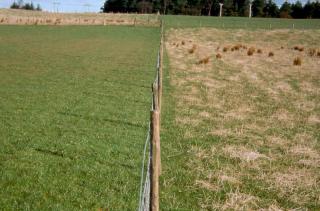Grassland Extensification: Impacts On Biodiversity And Animal Production
Published on 12 October 2009 in Sustainability and Communities , Ecosystems and biodiversity

Introduction
Improved grassland is common within Europe, particularly within the UK where it covers more than 5 million ha or 21 % of the land surface area. The equivalent figures for Scotland are 907,000 ha or 11.2 % (Countryside Survey figures from 2007). Past improvements to grassland to increase livestock production is associated with reduced biodiversity and consequently extensification of grassland management has been put forward as one way of redressing the biodiversity losses seen in agricultural landscapes. Changes in agricultural support payments also alter the pattern of land use in Scotland and knowledge of what happens when land management changes is vital for predicting the consequences for farm incomes and for biodiversity.
The impacts of changing the management of intensively managed pastures has been examined using two long-term (16 year) experiments at different sites where extensive grazing, abandonment and continued intensive grazing were compared by assessing impacts on productivity, soil chemistry, and species composition and plant diversity.
Key Points
Extensive grazing led to slow but continual changes in plant species composition, with some increase in diversity compared to intensive grazing. Abandonment led to rapid changes in composition followed by stabilisation, as there were no woody species nearby to invade and lead to further changes. However, abandonment did not affect plant species diversity. Thus, biodiversity gains from extensification within productive landscapes may be a slow process.
Agricultural productivity did not decline significantly with time in any of the treatments. Though the extensively managed treatments carried fewer sheep they produced ewes in better condition and larger lambs. At the drier of the two sites (Sourhope, 18 km SE of Kelso) it appeared that extensive grazing was better than intensive grazing at buffering the impacts of year-to-year variations in the weather on productivity.
Research Undertaken
Two experiments were initiated in 1990 and ran until 2005 at Hartwood in Lanarkshire and Sourhope in the Borders. They compared the impacts of continuing intensive pasture management for sheep with a range of three less intensive management options. Swards in the intensive treatment was kept at a height of 4 cm by adjusting the number of sheep present. The other three had their fertiliser use stopped and had three different levels of grazing intensity; one kept at 4 cm, one at 8 cm and one left ungrazed. Animal productivity, plant species richness and composition, and soil characteristics were all monitored regularly.
Policy Implications
Biodiversity gains appeared slowly after management intensity was reduced. This is partly a result of the inherent slow dynamics of grassland systems under grazing management and partly a result of the lack of suitable species in highly managed landscapes that could invade and spread. Substantial increases in biodiversity would require intensive restoration management.
Author
Prof. Robin Pakeman r.pakeman@macaulay.ac.uk
Topics
Sustainability and Communities , Ecosystems and biodiversity







